Sintra’s Crown Jewel and its Mythical Guardian
Nestled high amidst the verdant, mist-laden hills of Sintra, Portugal, stands the Palácio Nacional da Pena, or Pena Palace – a flamboyant, kaleidoscopic dreamscape that seems plucked from the pages of a fairytale. This 19th-century Romanticist castle, a jewel of Pena Palace Sintra and a UNESCO World Heritage site, is a testament to the vivid imagination of its creator.
Among its many architectural wonders and symbolic embellishments, the Triton Gate Pena Palace (Portão do Tritão) stands out as a particularly potent and memorable feature. More than just an archway, the Triton Gate Pena Palace is a dramatic sculptural statement, a mythical guardian, and a symbolic threshold into the fantastical world envisioned by King Ferdinand II.
This article delves deep into the history, design, detailed symbolism Triton Gate, and enduring allure of this magnificent structure, a masterpiece that continues to captivate visitors from around the globe.
To fully appreciate the Triton Gate Pena Palace, one must first understand the extraordinary context of Pena Palace itself. It is not merely a building; it’s an experience, a carefully curated journey through different architectural styles, cultural references, and natural beauty, all orchestrated to evoke powerful emotions and stir the imagination. The Triton Gate Pena Palace serves as a crucial narrative element in this journey, preparing the visitor for the wonders that lie beyond within the broader Pena Palace architecture.
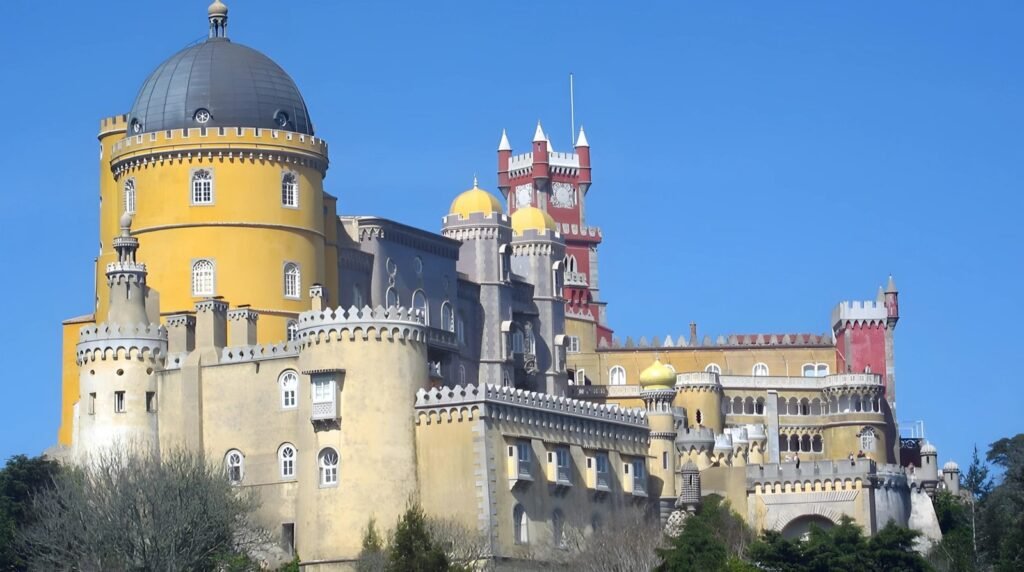
The Genesis of a Dream: Pena Palace and King Ferdinand II
The story of Pena Palace, and by extension its remarkable Triton Gate, is inextricably linked with King Ferdinand II of Portugal. Born Ferdinand of Saxe-Coburg and Gotha, a cousin to Queen Victoria’s husband Prince Albert, he married Queen Maria II of Portugal in 1836. Ferdinand was a man of immense culture, artistic sensibility, and a profound love for nature. He was an accomplished painter, engraver, and ceramicist, often dubbed the “Artist King.”
In 1838, King Ferdinand II acquired the ruins of the 16th-century Jeronymite Monastery of Our Lady of Pena, which had been severely damaged by the 1755 Lisbon earthquake and later abandoned after the suppression of religious orders in Portugal. Enchanted by the dramatic location and panoramic views, Ferdinand envisioned transforming the site into a summer residence for the Portuguese royal family. He wasn’t interested in a conventional palace; he sought something unique, something that would reflect the prevailing Romantic movement sweeping across Europe. The overall Pena Palace architecture would be his testament.
Romanticism, as an artistic and intellectual movement, emphasized emotion, individualism, the glorification of the past (especially the Middle Ages), and a deep appreciation for nature’s sublime power. Pena Palace became Ferdinand’s canvas, and he enlisted the German mining engineer and amateur architect Baron Wilhelm Ludwig von Eschwege to bring his vision to life. Construction began in 1842 and continued for several decades, even after Ferdinand’s death.
The resulting palace is an astonishing eclectic mix of styles: Neo-Gothic, Neo-Manueline (a revival of the ornate 16th-century Portuguese late Gothic style), Neo-Islamic, and Neo-Renaissance elements are all blended with a theatrical flair. Brightly colored facades – ochre, red, blue, and yellow – make the palace stand out dramatically against the lush green of the surrounding Pena Park, a vast arboretum also designed by Ferdinand, featuring exotic species from around the world. The Triton Gate Pena Palace perfectly embodies this eclectic and fantastical approach.
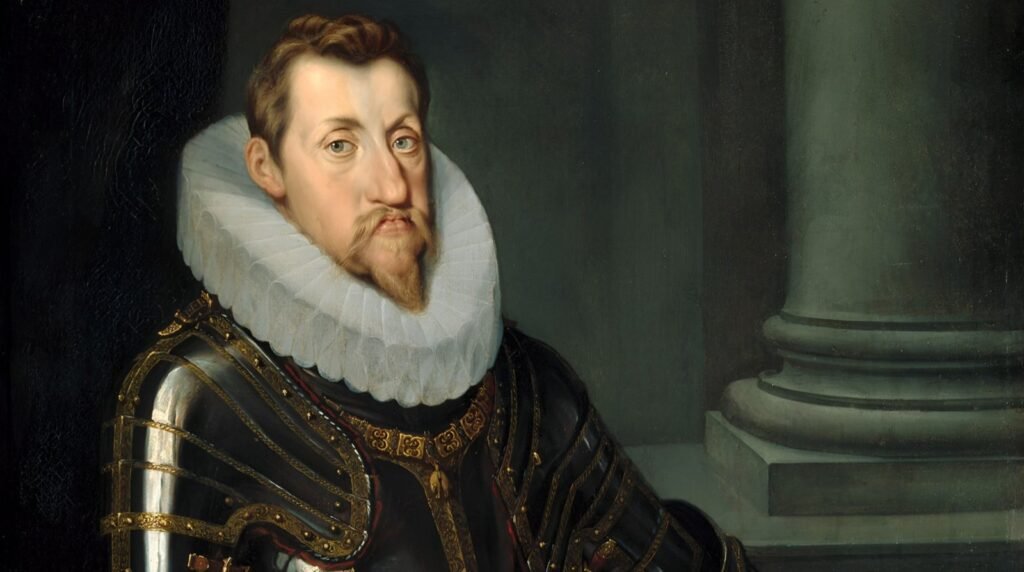
The Triton Gate: Location and Architectural Context
The Triton Gate Pena Palace is not the main entrance to the palace complex, but rather a significant allegorical archway encountered as one progresses through the palace’s intricate layout. It is specifically located on the Terrace of the Tritons, providing access to one of the palace’s most impressive sections, bridging the gap between the “Old Monastery” wing and the newer palatial wing constructed by Ferdinand. This particular element is a highlight within the celebrated Pena Palace architecture.
This placement is deliberate. As visitors navigate the winding paths and courtyards of Pena, the Triton Gate appears as a dramatic reveal, a moment of heightened fantasy. It acts as a symbolic portal, marking a transition into an even more mythical and imaginative realm within Ferdinand’s creation. The archway itself is relatively unadorned compared to the figure it supports, allowing the sculpture to dominate the viewer’s attention. Flanked by sturdy, crenelated walls and turrets, typical of the Romantic revival of medieval aesthetics, the gate feels both ancient and fantastical.
The Sculptural Marvel: A Closer Look at the Triton
The centerpiece of the gate is, of course, the colossal figure of a Triton. In Greek mythology, Triton is the son of Poseidon (the god of the sea) and Amphitrite (a sea goddess). He is typically depicted as a merman, with the upper body of a human and the tail of a fish. Triton acted as his father’s herald, using a twisted conch shell as a trumpet to command the waves, either calming them or stirring them into a frenzy.
The Pena Palace Triton is a powerful and dynamic representation:
- Form and Posture: The figure is half-man, half-fish, with a muscular human torso emerging from a scaly, coiling fish tail. His powerful arms are raised, seemingly supporting the weight of the archway or window above him. This posture imbues him with a sense of immense strength and endurance. His head is tilted, and his face bears a somewhat grotesque, almost anguished or fiercely determined expression, with deep-set eyes and flowing, seaweed-like hair and beard.
- Material and Texture: The sculpture is crafted from stone, but its surfaces are richly textured to enhance its mythical quality. The “skin” of the Triton’s human half is rendered with anatomical detail, while his fish tail features pronounced scales. The entire figure is enveloped in what appears to be a profusion of marine elements – shells, coral, and aquatic plants – which seem to grow organically around him and merge with the architectural structure. This blurs the line between sculpture and architecture, nature and artifice.
- The “Newt” Misconception: Interestingly, the figure is often locally and anecdotally referred to as a “newt” (tritão can also mean newt in Portuguese, though the mythological context is clear). While technically a Triton (a merman), the slightly monstrous, almost reptilian features of the face, combined with the sinuous, scaled lower body, might contribute to this colloquial naming. However, its iconographic roots are firmly in classical sea mythology.
The archway the Triton supports forms part of a window or a decorative element of the building facade above, linking the sculpture directly to the living spaces of the palace. This integration is key to Ferdinand’s vision, where art and architecture are inseparable.
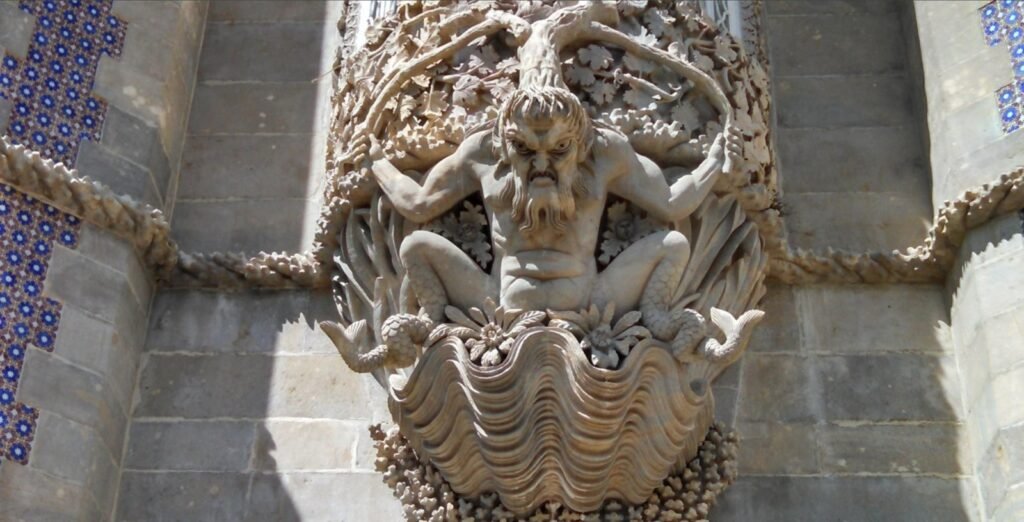
Symbolism and Interpretation: Unraveling the Meaning of the Triton Gate
The symbolism Triton Gate is laden with layers, reflecting King Ferdinand II’s interests and the broader themes of Romanticism. Understanding the symbolism Triton Gate enhances any visit to Pena Palace Sintra.
- Allegory of Creation: The most prominent interpretation regarding the symbolism Triton Gate, often attributed to Ferdinand’s vision, is that it represents an allegory of the creation of the world. The Triton, a primordial being of the sea, is depicted emerging from a giant seashell (symbolizing the embryonic world or the waters of chaos) and supporting the structure above, which can be seen as the newly formed world or cosmos. The marine encrustations and the water-like flow of his hair and beard reinforce this connection to the primordial waters from which all life emerged according to many creation myths.
- Portugal’s Maritime Heritage: For a nation like Portugal, with its profound and storied maritime history of exploration and discovery, the sea holds immense cultural significance. The Triton, as a powerful sea deity, can be seen as a nod to this heritage, a guardian of the seas that brought Portugal glory and connected it to distant lands. Pena Palace, perched high above the Atlantic, constantly reminds one of the ocean’s proximity.
- The Power of Nature: Romanticism celebrated the sublime and often terrifying power of nature. The Triton, a creature of the untamed ocean, embodies this raw, elemental force. His rugged appearance and the wild, organic forms surrounding him evoke the untamable aspects of the natural world, a theme deeply cherished by Ferdinand and reflected in the wild, seemingly untamed Pena Park.
- Guardian and Transition: Like many mythical figures at gateways, the Triton serves as a guardian. He protects the inner sanctums of the palace, and his formidable appearance might be intended to ward off malevolent spirits or, more metaphorically, to signify the transition from the ordinary world to a realm of fantasy and imagination. Passing under the Triton is like stepping through a magical portal.
- Ferdinand’s Personal Symbolism: King Ferdinand II was deeply interested in alchemy, mythology, and esoteric symbolism. The choice of a Triton, a figure bridging the human and the elemental, could reflect his fascination with transformation and the interconnectedness of all things. The entire palace is a personal expression, and the Triton Gate is a significant chapter in that visual narrative.
- Theatricality and Fantasy: Above all, Pena Palace is a work of fantasy architecture. The Triton Gate contributes significantly to its theatrical, almost operatic quality. It is designed to surprise, awe, and transport the visitor, much like a set piece in a grand Romantic opera or play.
Artistic and Architectural Significance
The Triton Gate is a remarkable example of 19th-century Romantic sculpture integrated into architecture.
Eclecticism: It aligns perfectly with the palace’s eclectic nature. While the figure is classical in its mythological origin, its execution has a distinctly Romantic, almost grotesque sensibility, diverging from the idealized forms of classical sculpture.
Craftsmanship: The carving, attributed to an unknown sculptor but undoubtedly executed under the close supervision of Baron von Eschwege and King Ferdinand II himself, demonstrates considerable skill in rendering the complex forms and textures. The way the figure seems to organically merge with the surrounding stonework is particularly masterful.
Narrative Architecture: The gate is a prime example of narrative architecture, where elements are designed not just for function or aesthetics but to tell a story or evoke a specific mood. It actively engages the visitor’s imagination.
Restoration and Conservation
Like the rest of Pena Palace Sintra, the Triton Gate has undergone restoration efforts over the years to preserve its intricate details and structural integrity. Exposure to the elements – wind, rain, and sun – particularly in such an exposed hilltop location, necessitates ongoing conservation. The materials, primarily stone, are susceptible to erosion and biological growth. Restoration projects focus on cleaning, repairing, and consolidating the stone, ensuring that this iconic feature remains for future generations to admire. The Parques de Sintra-Monte da Lua, the entity managing the site, invests significantly in these conservation efforts, employing expert techniques to maintain the authenticity of the palace.
Experiencing the Triton Gate: A Visitor’s Perspective
When visiting Pena Palace, the encounter with the Triton Gate Pena Palace is a memorable moment. After navigating parts of the palace exterior, often with breathtaking views of the surrounding landscape, one arrives at the Terrace of the Tritons. The gate commands attention, drawing the eye upwards to the powerful figure.
- Photography: It is one of the most photographed spots in Pena Palace, and for good reason. The interplay of light and shadow on the sculpture’s rugged surfaces, the vibrant colors of the palace walls nearby, and the backdrop of the Sintra hills make for stunning compositions.
- Contemplation: Beyond the photo opportunity, it’s worth pausing to contemplate the symbolism. Imagine King Ferdinand II conceiving this fantastical element, overseeing its creation, and imbuing it with layers of meaning.
- Detail Spotting: Look closely at the details – the expression on the Triton’s face, the “seaweed” hair, the shells and coral that seem to encrust him and the arch. These details enrich the experience and reveal the artistry involved.
The Triton Gate is more than just a picturesque feature; it is an intellectual and emotional anchor within the Pena Palace experience, a physical manifestation of the Romantic spirit.
Ready for more fascinating insights that spark your curiosity? Delve deeper into the unexpected with us. Explore our blog section for more strange and thought-provoking stories that uncover the world’s most bizarre happenings.


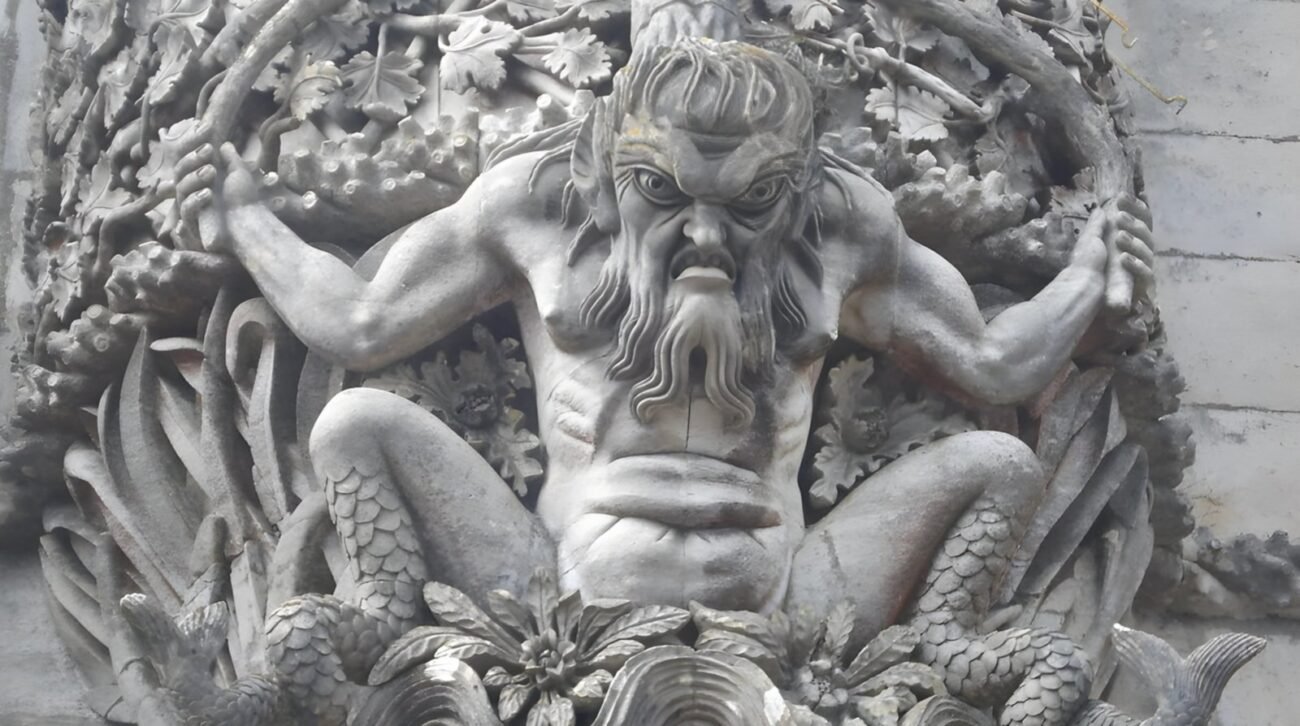
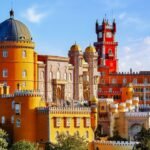










One thought on “The Triton Gate Pena Palace: Unveiling its 19th-Century Majesty & Symbolism”